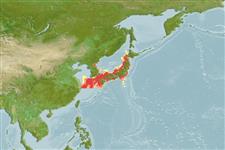Environment: milieu / climate zone / depth range / distribution range
Ökologie
seewasser demersal; ozeanodrom (Ref. 51243). Subtropical; 45°N - 30°N
Northwest Pacific: southern Hokkaido to Kyushu and the southern Korean Peninsula (Ref. 559). Three morphotypes observed (reddish type; blackish type; brownish type), and may be reproductively isolated from each other (Ref. 44259).
Length at first maturity / Size / Gewicht / Alter
Maturity: Lm ?, range 16 - ? cm
Max length : 35.9 cm TL Männchen/unbestimmt; (Ref. 96735); max. veröff. Gewicht: 800.00 g (Ref. 40637)
Juveniles associate with drifting seaweed. Plankton feeder (Ref. 12114, 12115). Viviparous (Ref. 34817).
Males established territories ranging from 12 to 70 sq. m; initiated courtship when females approached the territories; lateral display, rushing and turning movements were frequently observed during courtship. Mating pair formed about 30 min before copulation; the pair ascended to 1.5-2.0 m above bottom then males suddenly coiled around the body of females to copulate.
Masuda, H., K. Amaoka, C. Araga, T. Uyeno and T. Yoshino, 1984. The fishes of the Japanese Archipelago. Vol. 1. Tokai University Press, Tokyo, Japan. 437 p. (text). (Ref. 559)
IUCN Rote Liste Status (Ref. 130435: Version 2024-1)
Bedrohung für Menschen
Harmless
Nutzung durch Menschen
Fischereien: kommerziell; Aquakultur: kommerziell; Sportfisch: ja
Tools
Zusatzinformationen
Download XML
Internet Quellen
Estimates based on models
Preferred temperature (Ref.
123201): 9.3 - 22.1, mean 17.3 °C (based on 52 cells).
Phylogenetic diversity index (Ref.
82804): PD
50 = 0.5000 [Uniqueness, from 0.5 = low to 2.0 = high].
Bayesian length-weight: a=0.01288 (0.00989 - 0.01677), b=3.02 (2.96 - 3.08), in cm total length, based on LWR estimates for this species (Ref.
93245).
Trophic level (Ref.
69278): 4.0 ±0.67 se; based on food items.
Generation time: 4.4 ( na - na) years. Estimated as median ln(3)/K based on 1
growth studies.
Widerstandsfähigkeit (Ref.
120179): mittel, Verdopplung der Population dauert 1,4 - 4,4 Jahre. (K=0.25).
Fishing Vulnerability (Ref.
59153): Moderate vulnerability (38 of 100).
Nutrients (Ref.
124155): Calcium = 53.1 [20.6, 174.2] mg/100g; Iron = 0.62 [0.26, 1.68] mg/100g; Protein = 18.3 [17.0, 19.7] %; Omega3 = 0.645 [0.255, 1.731] g/100g; Selenium = 82.5 [29.3, 254.6] μg/100g; VitaminA = 10.6 [2.9, 40.2] μg/100g; Zinc = 0.447 [0.234, 0.827] mg/100g (wet weight);
